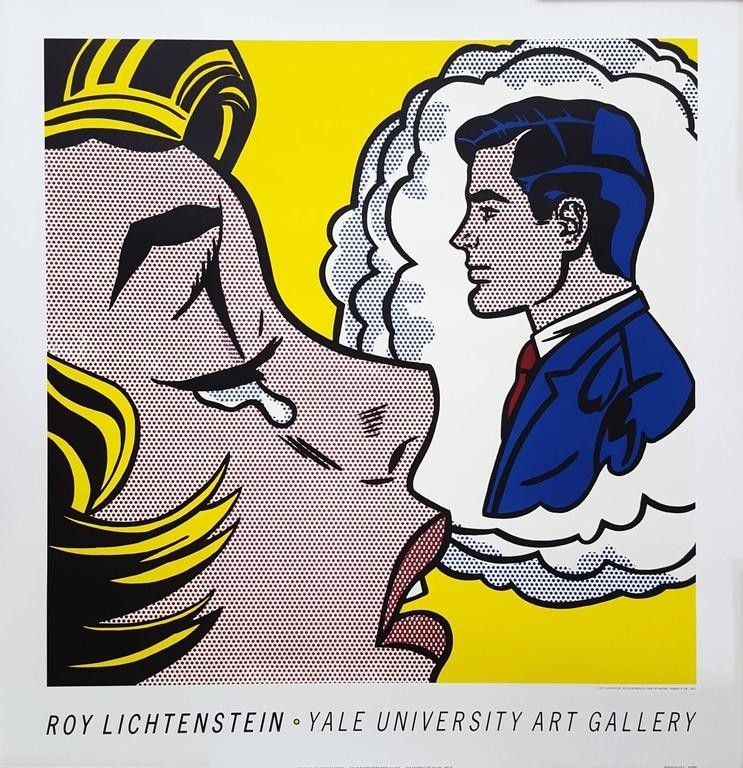Roy Lichtenstein: In this article, you would know everything about Roy Lichtenstein– From his childhood to death– Life, paintings, contribution, death- Easy explanation.
Roy Lichtenstein Facts
Exhibitions
Roy Lichtenstein was the first pop art artist (American) who became first American to be exhibited at the United Kingdom gallery (Tate Gallery). Tate Gallery is an institution that is the network of four art museums.
The paintings of Roy Lichtenstein were featured at the Tate Gallery on the occasion of the show “54-64”. And his paintings got the title – Painting and Sculpture of a Decade, and this was also the name of Exhibition.
Pasadena Art Museum of California had held his first museum retrospective in 1967. Same year, Roy Lichtenstein’s first solo exhibition was held in Amsterdam.
After this success, Roy Lichtenstein participated in Documenta (Exhibition of contemporary art which takes place after every five years).
Following is the detail of exhibitions (Solo/Group) of Roy Lichtenstein with proper explanation.
Pasadena Art Museum- The member of this museum had organised Roy Lichtenstein’s first exhibition (Museum retrospective exhibition) in 1957. Pasadena Art Museum was its previous name, now its name is Norton Simon Museum. It’s an art museum situated in Pasadena (California).
Guggenheim Museum- This museum had arranged the first retrospective of Roy Lichtenstein in 1969. Diane Waldman had organised this programme. This museum is located in New York City and often referred to as “The Guggenheim”. It is located at 1071 Fifth Avenue (Corner of East 89th street- Manhattan).
Museum of Modern Art- Roy Lichtenstein was the first living artist, for whom, Museum of Modern Art had exhibited solo drawing exhibition. This museum is located in Midtown Manhattan (New York City).
Commissions
German photographer, Fritz Gunter Sachs had given artwork to Roy Lichtenstein, for which he was commissioned by German photographer (Fritz Gunter Sachs) in 1969.
Fritz Gunter Sachs had said to create artwork for the collector’s Pop Art (similar to Dadaism) bedroom suite at the Badrutt’s Palace Hotel in Switzerland.
Roy Lichtenstein major commissions during the 1980s for work in public places such as- Mermaid (1979) in Miami Beach, Lamp (1978) in St. Mary’s, Georgia and 26 feet tall Brushstrokes (1984) at Port Columbus International Airport.
Roy Lichtenstein had worked with car manufacturing company BMW. In 1977, he painted Group 5 Racing Version of BMW. German automaker BMW had manufactured this car.
The manufacturer of this car had paid commission (art fees) for the painting on this car.
Following are the artworks for Roy Lichtenstein– For which, he had received a hefty amount of money.
Georgia; Mermaid (1979)- This big sculpture (640 cm × 730 cm × 330 cm) is located in Miami Beach (Jackie Gleason Theatre). It’s a big statue in which Roy Lichtenstein had used raw material such as steel, polyurethane, palm tree, concrete and enamel. It was his first art commission.
Brushstrokes in Flight (1984)- Roy Lichtenstein had made this sculpture in 1984. Still, you can see this sculpture at the John Glenn Columbus Airport. It includes several other sculptures and paintings.
Mural with Blue Brushstroke (1984–85)- It a mural painting that is located in the New York City (Atrium of the Equitable Tower). It was also the subject of Roy Lichtenstein’s book: “Mural with Blue Brushstroke”.
Roy Lichtenstein paintings
Roy Lichtenstein is known for painting and sculpting who also joined the pop art movement of New York City (Manhattan). He also became an honourable member of “The Independent Group” whose paintings blurred the line between high art and low art.
We see many paintings made by Roy Lichtenstein- Brattata (1962), Engagement Ring (1961), Girl with Ball (1961), Roto Broil (1961), Blam (1962), I Can See the Whole Room…and There’s Nobody in It! (1961) and so on.
In each painting, he has depicted mundane objects and daily use things in a funny way, and his parody style was so unique such in the painting- I Can See the Whole Room…and There’s Nobody in It! Of 1961, he has depicted a man seeing through a round hole.
It’s a painting in which a person wants to express his suspicious expression.
Description of a few paintings:
Ten Dollar Bill of 1956: Roy Lichtenstein had made this lithographic drawing (Proto pop art) in the year 1956. This is referred to as the beginning of Lichtenstein’s artwork in the field of Pop art movement.
Electric Cord of 1961: The cost of this painting was estimated in Oct 2012, and its estimated cost was $4 million, this pop art painting was made in 1961, but in 2012, this painting was returned to the Leo Castelli’s widow.
At that time, the cost of this painting was $750. But in 2012, its price was $4 million.
Engagement Ring of 1961: This painting is based on Winnie Winkle series, and many cartoons magazines featured this painting in their story column, but this was not same painting.
Roy Lichtenstein had changed its narrative accompaniment and graphical description. In his most Romantic comic books, we see this image (painting).
Crying girl of 1963: Crying girl is the reference of two very different works of Roy Lichtenstein.
First is- It’s an offset lithograph of 1963, this was made on wove paper (off white).
Second is- It’s a porcelain enamel that was made in 1964 on steel.
